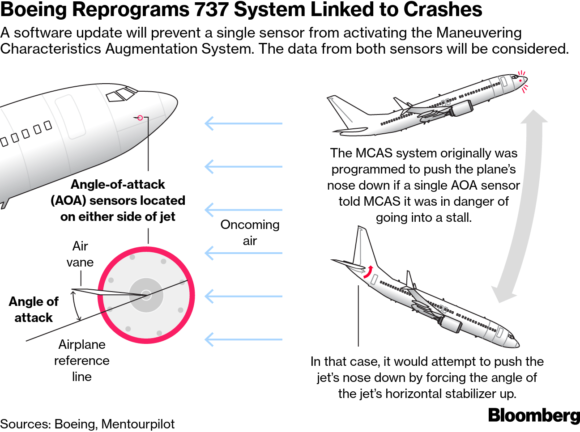The stall-prevention system on a Boeing Co. 737 Max jet automatically switched on before the plane crashed in Ethiopia this month, the Wall Street Journal reported, citing initial findings from the plane’s flight data.
The conclusion was relayed at a briefing at the U.S. Federal Aviation Administration on Thursday and is the strongest indication yet that the same system malfunctioned in both the Ethiopian Airlines flight and the Lion Air disaster in Indonesia in October, the newspaper said.
A preliminary report from Ethiopian authorities is expected within days, though the preliminary conclusions — based on analysis of the aircraft’s black boxes — could still change, the people briefed on the matter told the Wall Street Journal. A representative for Boeing said the company was unable to comment on the investigation.
The U.S. planemaker, working with regulators, has spent months refining the 737 Max’s software since data from the Lion Air crash indicated the stall-avoidance system had repeatedly tipped the nose down before pilots lost control. Boeing was close to a software fix when the Ethiopian Airlines jet went down on March 10.
Air-crash experts have been using flight-data and cockpit-voice recordings recovered from the Ethiopian Airlines wreckage to piece together events leading up to the tragedy, which killed all 157 people on board. Parallels with the loss of an identical Lion Air plane led to a global grounding of the Max model and have given the probe added urgency.
The Ethiopian investigation has focused on the anti-stall system, which in the case of the Lion Air crash exerted more and more force until the crew lost control. The software had kicked in on the same aircraft the day before, when an off-duty pilot riding in the cockpit was able to save the plane by helping to cut the power to the rogue system.
The feature, known as the Maneuvering Characteristics Augmentation System, was designed to keep the Max from climbing too steeply and stalling. The U.S. Transportation Department has begun an inquiry into how it was approved as part of the Max’s certification in 2017, while the Justice Department is using a grand jury to gather information.
Officials from the two departments and the Federal Bureau of Investigation began digging into a range of matters related to MCAS within weeks of the Lion Air loss, Bloomberg has reported.
There’s no explanation of the MCAS — nor the steps needed to counter it — in the Max’s U.S. and European pilot manuals. Boeing reasoned that crews were already drilled to counter similar behavior by the 737’s horizontal stabilizer, running through a checklist to flip two center-console switches. The Federal Aviation Administration reviewed the U.S. company’s analysis and agreed.
With Boeing’s best-selling model out of action and its future in the balance, establishing the cause of the Ethiopian tragedy has become critical.
Boeing has said its planned software update and further pilot training guidelines for the Max will address concerns. The planemaker will stop charging for a safety feature called the disagree light, activated if a plane’s sensors — which can trigger the MCAS — are at odds.
Was this article valuable?
Here are more articles you may enjoy.


 Ireland and UK Face High Wildfire Risks After Dry, Warm Weather
Ireland and UK Face High Wildfire Risks After Dry, Warm Weather  Family of Canadian CEO Killed in Helicopter Crash Files $35 Million Lawsuit
Family of Canadian CEO Killed in Helicopter Crash Files $35 Million Lawsuit  AI Beats Traditional Weather Models in Forecasting Wildfires
AI Beats Traditional Weather Models in Forecasting Wildfires  Fed’s Powell Says Tariff Impact Likely to Be Larger Than Expected
Fed’s Powell Says Tariff Impact Likely to Be Larger Than Expected 